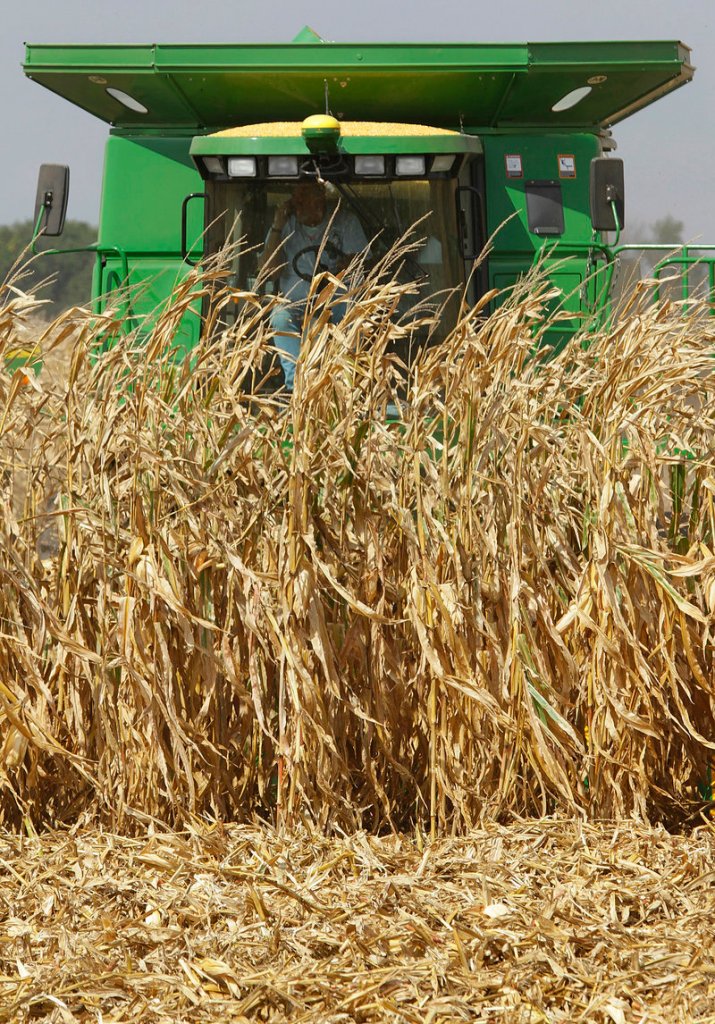Americans should brace for higher food prices this year now that demand for corn has pushed U.S. supplies to their lowest point in 15 years.
Higher projected orders from the ethanol industry sent corn futures soaring Wednesday, as corn supplies became the latest commodity to plummet. Low levels of wheat, coffee, soybeans and other food staples have already sent prices surging on the global market.
As those reserves decline, U.S. food companies are warning of retail price increases.
The ethanol industry’s projected corn orders this year have risen 8 percent, to 13 billion bushels, after record-high production in December and January, the Agriculture Department said Wednesday.
That means the United States will have a reserve of 675 million bushels left over in late August when this year’s harvest begins. That’s roughly 5 percent of all corn that will be consumed, the lowest surplus level since 1996.
The USDA report measures global supply and demand for grains, oilseeds and other crops. The department said its projections for wheat and soybean reserves remained unchanged at historically low levels.
The price of corn affects most food products in supermarkets. It’s used to feed the cattle, hogs and chickens that fill the meat aisle. It is the main ingredient in Cap’n Crunch and Doritos. Turned into corn syrup, it sweetens most soft drinks.
The decline in reserves caused corn futures to surge, with prices rising 3 percent to settle at $6.98. Corn prices have already doubled in the last six months, rising from $3.50 a bushel to nearly $7 a bushel. Analysts expect the price increases to continue in coming months.
“I think we have a chance to test the all-time high” price of $7.65 a bushel, said Telvent DTN analyst John Sanow. The tight level of reserves leaves little margin for error if there are production problems this year.
Major food makers and some restaurants have already said they’ll be raising prices this year because they’re paying more for corn, wheat, sugar, coffee and chocolate, all of which are at historically high prices. Weather, such as flooding in Australia and droughts elsewhere, has affected many crops this year.
A severe drought in China, the world’s largest wheat grower, could force prices even higher. The U.N.’s food agency has warned that the drought is driving up the country’s wheat prices, and now the focus is on whether China will buy more from the global market, where prices have already risen about 35 percent since mid-November.
Consumers will likely see price hikes as early as three months from now, though most of the impact won’t be felt for another six months, said Scott Irwin an agriculture economics professor at the University of Illinois. Chicken prices are among the first to rise because the bird’s life span is so short that higher feed costs get factored in quickly, he said. Price hikes for hogs take about a year and cattle two years, while packaged foods take six or seven months to start rising.
Some food makers already began selectively raising prices within the past few quarters.
Those higher prices are filtering into stores. Supermarkets have resisted price increases for some time, hoping to hold onto their cost-conscious customers in the tough economy. But chains such as Kroger now also say higher prices are coming.
Cereal maker Kellogg Co. said last week it plans to raise prices by 3 to 4 percentage points. Sara Lee Corp. said Tuesday that it will continue its price increases as it copes with higher commodity costs. The company said the price it pays for coffee beans alone is up 60 percent compared with last year.
And J.M. Smucker Co. said Tuesday that it would raise prices again on Folgers and Dunkin Donuts coffee for the third time this year, by 10 percent on average. A large can of Folgers is already going for around $12 at many markets.
It’s not just playing out in the grocery store. McDonald’s Corp. said last month that it may raise prices this year as its own food tab rises. The company already raised prices in some markets, including the United Kingdom.
Rising grain costs hit meat producers first. Tyson Foods, the nation’s biggest meat company, says it is aiming to cut $200 million in operational costs to offset higher corn and soybean costs. CEO Donnie Smith calls that the “new normal” price range. Tyson said chicken, beef and pork prices are expect to rise, if only slightly, this year as producers seek to cover costs.
Shares of meat producers like Tyson, Smithfield Foods and Pilgrim’s Pride opened lower Wednesday, falling less than 1 percent in early trading.
.
Send questions/comments to the editors.



Success. Please wait for the page to reload. If the page does not reload within 5 seconds, please refresh the page.
Enter your email and password to access comments.
Hi, to comment on stories you must . This profile is in addition to your subscription and website login.
Already have a commenting profile? .
Invalid username/password.
Please check your email to confirm and complete your registration.
Only subscribers are eligible to post comments. Please subscribe or login first for digital access. Here’s why.
Use the form below to reset your password. When you've submitted your account email, we will send an email with a reset code.